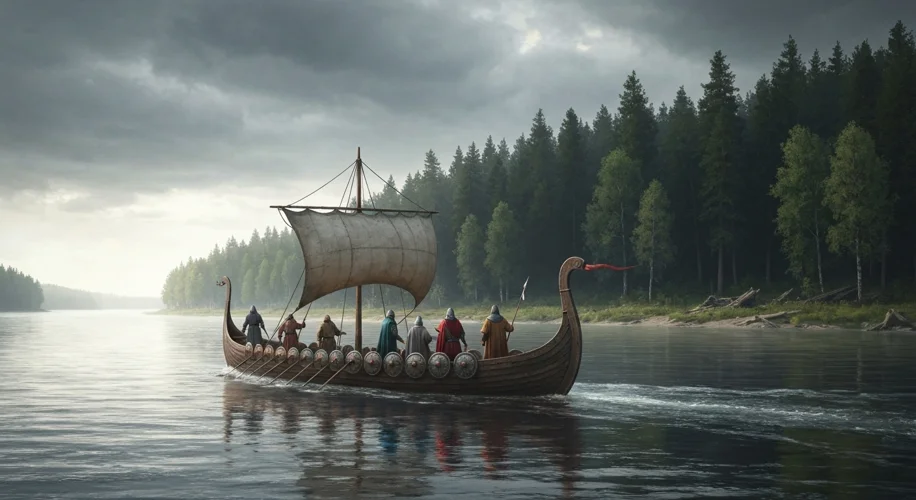In the vast tapestry of Eastern European history, few threads are as intricately woven and hotly debated as the origins of the Rus’ people and the foundational state of Kievan Rus’. For centuries, the narrative of this powerful medieval polity has been a cornerstone for understanding the ethno-historical development of Russia, Ukraine, and Belarus. Yet, beneath the surface of this established history lie complex scholarly debates, often influenced by contemporary political currents, that seek to unravel the precise lineage and the very identity of these early East Slavs.
The story begins in the turbulent centuries following the decline of the Western Roman Empire, a period often referred to as the Migration Period or the “Dark Ages.” Into this cauldron of shifting populations and nascent state formations emerged a people known as the Rus’. The earliest written accounts, primarily from Byzantine and Arab sources, begin to mention them in the 8th and 9th centuries. These were not merely scattered tribes; rather, they were often depicted as organized groups, skilled in trade and warfare, navigating the crucial river routes that connected the Baltic Sea to the Black Sea and beyond.

The prevailing historical narrative, often associated with the “Normanist” or “Varangian” theory, suggests that the Rus’ were predominantly of Norse (Viking) origin. According to this view, groups of Scandinavian warriors, merchants, and adventurers, known as Varangians, migrated eastward, establishing trade routes and asserting dominance over local Slavic and Finnic tribes. The Primary Chronicle, a foundational East Slavic text compiled centuries later, recounts a legendary invitation by the Slavic tribes to a Varangian prince, Rurik, to rule over them, purportedly to end internal strife. Rurik and his kinsmen are said to have established their authority in Novgorod, and their descendants, particularly Oleg, are credited with conquering Kyiv in the 9th century, thus forming the nucleus of Kievan Rus’.
However, this interpretation has faced significant scholarly scrutiny and counter-arguments, particularly from historians who emphasize the indigenous Slavic contribution. The “Anti-Normanist” or “Normanist-critical” perspective argues that the Primary Chronicle’s account might be a later embellishment, potentially used to legitimize a Norse ruling dynasty. These scholars point to archaeological evidence that suggests a significant presence of local Slavic elites and administrative structures predating or developing concurrently with the arrival of the Norse. They also highlight the predominantly Slavic names found in early Rus’ chronicles and the gradual assimilation of the Norse settlers into the broader East Slavic population. The very term “Rus’,” they contend, may have originated from a local Dnieper river settlement or a Slavic tribal name, rather than being solely a Norse import.
The establishment of Kievan Rus’ around the 9th century marked a pivotal moment. Kyiv, strategically located on the Dnieper River, became the vibrant capital of a burgeoning state that stretched across a vast territory. This state was a melting pot of cultures, integrating Norse, Slavic, Finnic, Baltic, and even Turkic elements. The conversion of Prince Vladimir the Great to Orthodox Christianity in 988 AD was a watershed event, profoundly shaping the cultural, religious, and political identity of the region for centuries to come. It cemented ties with the Byzantine Empire, bringing with it a rich tradition of law, administration, and art.
The legacy of Kievan Rus’ is deeply significant for Ukraine. Kyiv was its undisputed heartland, the seat of its rulers, and the center of its spiritual and cultural life. The historical and cultural continuity from Kievan Rus’ to modern Ukraine is a cornerstone of Ukrainian national identity. This historical connection is often cited as a primary argument for Ukraine’s distinct historical trajectory, separate from, yet related to, other East Slavic nations.
For Russia, Kievan Rus’ represents the earliest stage of its statehood, the cradle from which its historical development sprang. Moscow’s later rise to prominence, particularly after the Mongol invasions that devastated the southern principalities, led to a different historical narrative that often emphasized continuity from the northeast. This has created a historical tension where both nations draw upon the same wellspring of Kievan Rus’ history, but with differing interpretations of emphasis and lineage.
The scholarly debate over the origins of the Rus’ and the precise nature of the founding of Kievan Rus’ continues to evolve, informed by new archaeological finds and reinterpretations of historical texts. While the “Normanist” theory, emphasizing a significant Norse element in the formation of the ruling elite, remains influential, it is increasingly understood as part of a more complex, multi-ethnic process. The reality was likely a dynamic interaction between incoming Norse groups and the indigenous East Slavic populations, where power, trade, and cultural exchange forged a new political entity.
Ultimately, understanding the ancient roots of the Rus’ is not merely an academic exercise in tracing genealogies. It is about understanding the very foundations of a civilization that profoundly influenced the cultural and political landscape of Eastern Europe. The story of the Rus’ is a testament to the complex, often contested, nature of history, where identity, statehood, and legacy are continually re-examined, revealing the enduring echoes of the past in the present.

